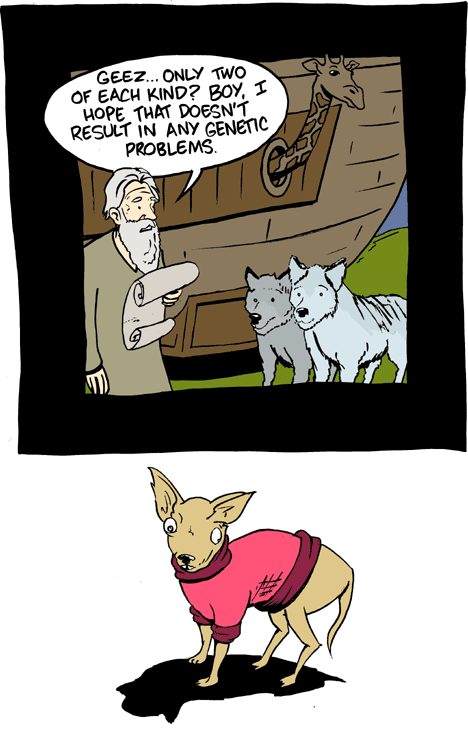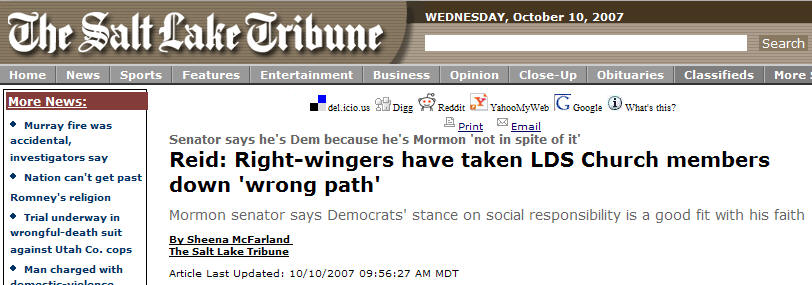UPDATED 01/12/07: A more general critique of Feldman’s article can be found over at GetReligion.
Noah Feldman, in today’s New York Times Magazine, puts forth a thesis about “Mormon secrecy” that just is ill-informed. Feldman clearly has access to certain bits of historical information about the Church, but in his effort to establish his main thesis — that the LDS Church is committed to “secrecy” regarding its beliefs — he displays a significant lack of knowledge about the Church itself. To wit:
Like Mormon ritual, much of Mormon theology remains relatively inaccessible to outsiders. The text of the Book of Mormon has always been spread to a broad audience, but the text is not a sufficient guide to understanding the details of Mormon teaching. Joseph Smith received extensive further revelation in the nature of sacred secrets to be shared with only a handful of close associates and initiates within the newly forming church.
First, of course, is the long-standing issue (within LDS circles) as to whether a “Mormon theology” even exists (since, for the most part, there are no “Mormon theologians” nor a “school of Mormon theology”). But setting that aside, I would suspect that Feldman has not spent much time inside an LDS church or a Deseret Book bookstore; I suspect that he has not searched the online “Gospel Topics” section at LDS.org, nor its on-line “Gospel Library“, including archives of LDS General Conference Addresses, various current lesson manuals, and the online version of The Encyclopedia of Mormonism. All these are freely and publicly available to anyone; indeed, the Church works very hard to promote all these sections. In short, while claiming an LDS effort at doctrinal secrecy, he appears to have failed to actually reviewed what the LDS Church says and promotes about its own doctrine.
He also appears to gloss over the fact that the LDS Church has sent out over one million missionaries to preach its message of the Restoration since its founding in 1830, with over 50,000 serving worldwide currently. My experience is that most people outside of the LDS Church complain that we try to tell them too much about our religion, rather than too little.
Beyond that, Feldman’s particulars regarding “Mormon secrecy” — a concept that comes straight out of evangelical anti-Mormon literature — are wrong and could have been easily refuted had he bothered to do a modicum of research. For example, he states:
The course was set for the Mormon religious practice of the 20th century: a process of mainstreaming, both political and theological. The less said the better about the particular teachings of the church, including such practices as the baptism of the dead and the doctrine of the perfectibility of mankind into divine form.
Actually, those two “particular teachings” have always been a key part of the missionary discussions (under “Plan of Salvation”), at least since I served my own full-time mission back in 1972-74. If Feldman had actually looked through Preach My Gospel, the standard LDS missionary discussion guide used by 50,000+ LDS missionaries in teaching investigators worldwide — publicly and cheaply ($6-$9) available via LDS Distribution Services, Deseret Book, and the BYU Bookstore, as well as downloadable as a free PDF file — he would have found the following:
The Savior loves all people and desires their salvation. Yet millions of people have died without having any opportunity to hear the message of the restored gospel of Jesus Christ or receive saving ordinances. Through His loving grace and mercy the Lord makes salvation possible for everyone who did not have the opportunity to receive, understand, and obey the gospel during their mortal lives. The gospel is preached to those deceased people in the spirit world. Members of the Church on earth perform the saving ordinances in behalf of their deceased ancestors and others. Deceased persons living in the spirit world have the opportunity to accept or reject the gospel and the ordinances performed in their behalf.
For this reason, Church members search for information about their ancestors. They complete pedigree charts and family group records and submit the names of deceased relatives who need to have saving ordinances performed on their behalf in sacred temples, This is family history work. Worthy members ages 12 and over, including new members, may receive from their bishop a recommend to perform baptisms for the dead. (p. 86)
And again:
Those who have repented of their sins and received the ordinances of the gosepl and kept the associated covenants will be cleansed by the Atonement of Christ. They will receive exaltation in the highest kingdom, also known as the celestial kingdom. They will live in God’s presence, become like Him, and receive a fullness of joy. (p. 53)
* Exaltation: Eternal life in God’s presence; to become like our Father in Heaven and live in His presence. The greatest of all the gifts of God. Exaltation comes through the Atonement of Christ and through obedience to all the laws and ordinances of the gospel. (p. 58)
So much for the “secret” doctrines.
Beyond that, Feldman appears to commit a version of the Pauline Kael fallacy (“How could Nixon have won? Nobody I know voted for him!”). He assumes LDS secrecy, probably because he — unlike literally millions and millions of people worldwide — has never actually had the missionary discussions, and he probably doesn’t know anyone who has, so he just doesn’t know what LDS missionaries actually teach. He takes the one area of LDS sacred ritual, the temple, and attempts to conflate it — without any real evidence or justification — into a general Mormon tendency towards secrecy. His unsupported (and unsupportable) thesis drives his article, when instead he should have done actual research first and spared himself some embarrassment.
I would recommend that Feldman pick up Preach My Gospel (or download the PDF version) as well as this year’s LDS Relief Society/Priesthood Study Guide, Teachings of the Presidents of the Church: Joseph Smith (also available on-line), and read them both. Then maybe he’ll be a bit more qualified to talk about LDS doctrine and its public availability. ..bruce..
[UPDATED 01/06/08 1922 MST — Welcome visitors from the Deseret News LDS Newsline! Feel free to look around. ]


